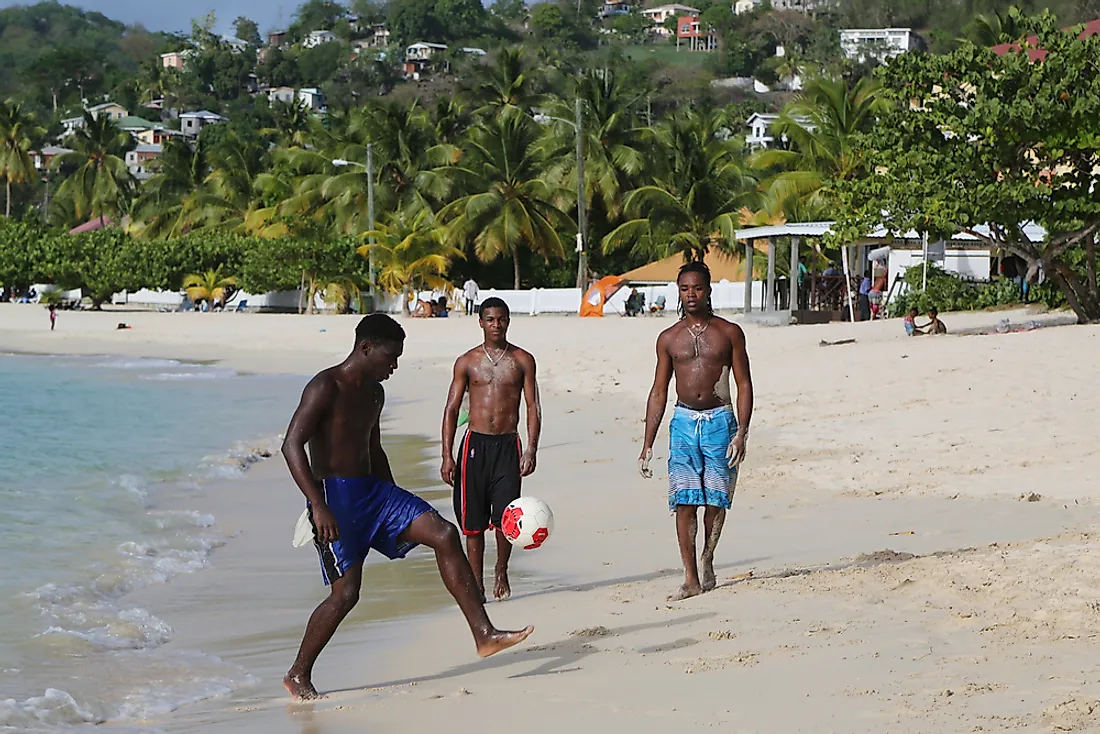What Is The Ethnic Composition Of Grenada?

Grenada is a Caribbean state that is located at the southernmost end of the Grenadine islet in the West Indies. It occupies an area of about 134.6 sq miles and has a population of approximately 112,200 people. Grenada is composed of Grenada Island and six other islets situated on the northern side of the main island. Grenada is also referred to as the "Island-of Spice" because of its high mace and nutmeg production.
Before the arrival of the Europeans, this island was inhabited by the Arawaks and the Kalinagos. Christopher Columbus discovered the island during his third-voyage to the American continents. Even though there is no record of the Spanish settling or landing on the Island, Grenada was considered to be owned by Spanish Monarch. The French colonization and settlement which lasted for over a century in the region began in 1650. The French ceded the island to the United Kingdom after they signed the Paris Treaty on February 10, 1763. The United Kingdom ruled over the island until 1974, except for a small period of French from 1779 to 1783. Grenada was granted total autonomy in 1976 with Herbert Blaize as its first-Premier. The country was granted total independence on February 7, 1974, with Eric Matthew as its first Prime minister and Queen Elizabeth as the head-of-state.
Demographics Of Grenada
Grenada is the thirteenth most populous Caribbean state which had an estimated population of about 107,317 people in 2016. Grenada experienced a population growth of about 0.23% from 2001 (103,137 people) to 2011 (105,539 people). The country’s fertility rate was about 2.21 in 2013. Grenada experienced a natural population growth of 792 people from 2013 to 2014, and this included 1,750 live births and 958 deaths. According to the 2001 census, over 89.4% of Grenadians are of African-descent while 8.2% of the population is mixed race. Other ethnic groups include East Indians (1.6%), European (0.4%), Chinese (0.02%), and Syrians/Lebanese (0.04%). Some of the Indian indenture workers were brought to the country from 1857 to 1885, from Uttar Pradesh and Bihar. A small percentage of the Arawaks and Caribs survived during the French-purge of Sauteurs. Currently, over 2.2% of the residents are of Indian descent. Grenada has a small community of English and French descendants. Just like most Caribbean islands, Grenada experiences a huge amount of out-migration. Most young people travel abroad looking for better-paying jobs.
Afro-Grenadians
Afro-Grenadians are the offspring of the African slaves who live in Grenada. John Clarke, a Black-History professor, coined the term Afro-Grenadian in his work titled "A Note on Racism-in-History". Many people prefer calling themselves Black Caribbeans or simply Black. Grenada had 525 African slaves who were working on the 52 Indigo plantations and 3sugar estates by 1700. After the British took over the island, when they signed the Paris Treaty, they started importing their slaves to work on their tobacco, sugar, and cotton plantations. A huge percentage of the African slaves were brought from Ghana (18,000) and Nigeria (37,000).
Indo-Grenadians
Indo-Grenadians are the largest minority group in the country. Indo-Grenadians can trace their roots to India. The Indo-Grenadians were introduced in Grenada during the second half of the nineteenth century when indenture laborers were imported. A distinct Indian cultural identity became visible in the country by the second half of the twentieth century. Immigration was legalized in Grenada to facilitate the arrival of indentured workers from India.
The Caribs
The Caribs, also referred to as the Kalinago or Island Caribs, are a native community of the Lesser-Antilles. The Kalinagos are the descendants of the Kalinas. The Caribs were the most dominant community in the region at the time the Spanish arrived at the Caribbean. They lived in Dominica, Windward Islands, Barbados, and Trinidad and Tobago. The Kainagos migrated to the Caribbean from River Orinoco in 1200AD. The Caribs displaced the Tainos by assimilation, extermination, and warfare. Currently, numerous Carib descendants are living in various countries including Guadeloupe, Antigua and Barbuda, St Lucia, Dominica, Martinique and Grenada, among others. There were about 125 Caribs in Grenada by 2001.











